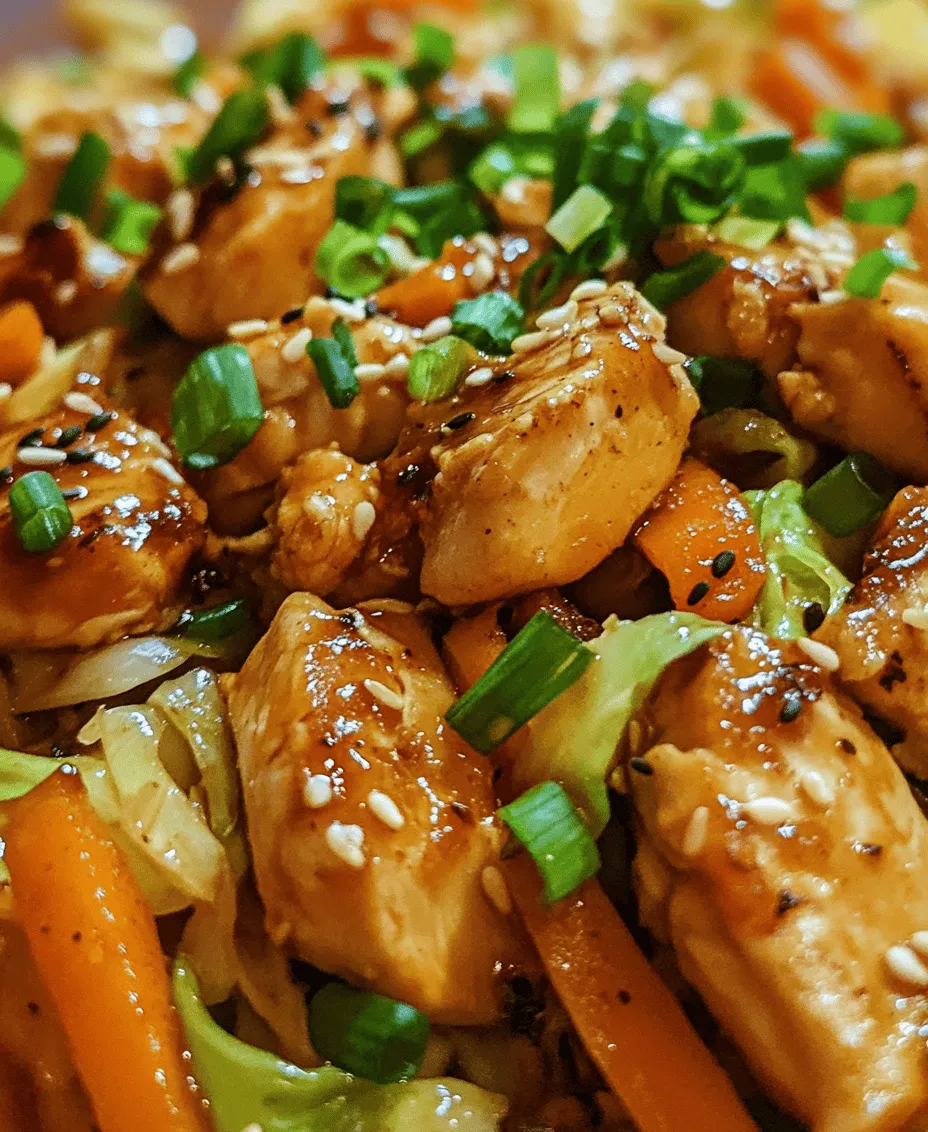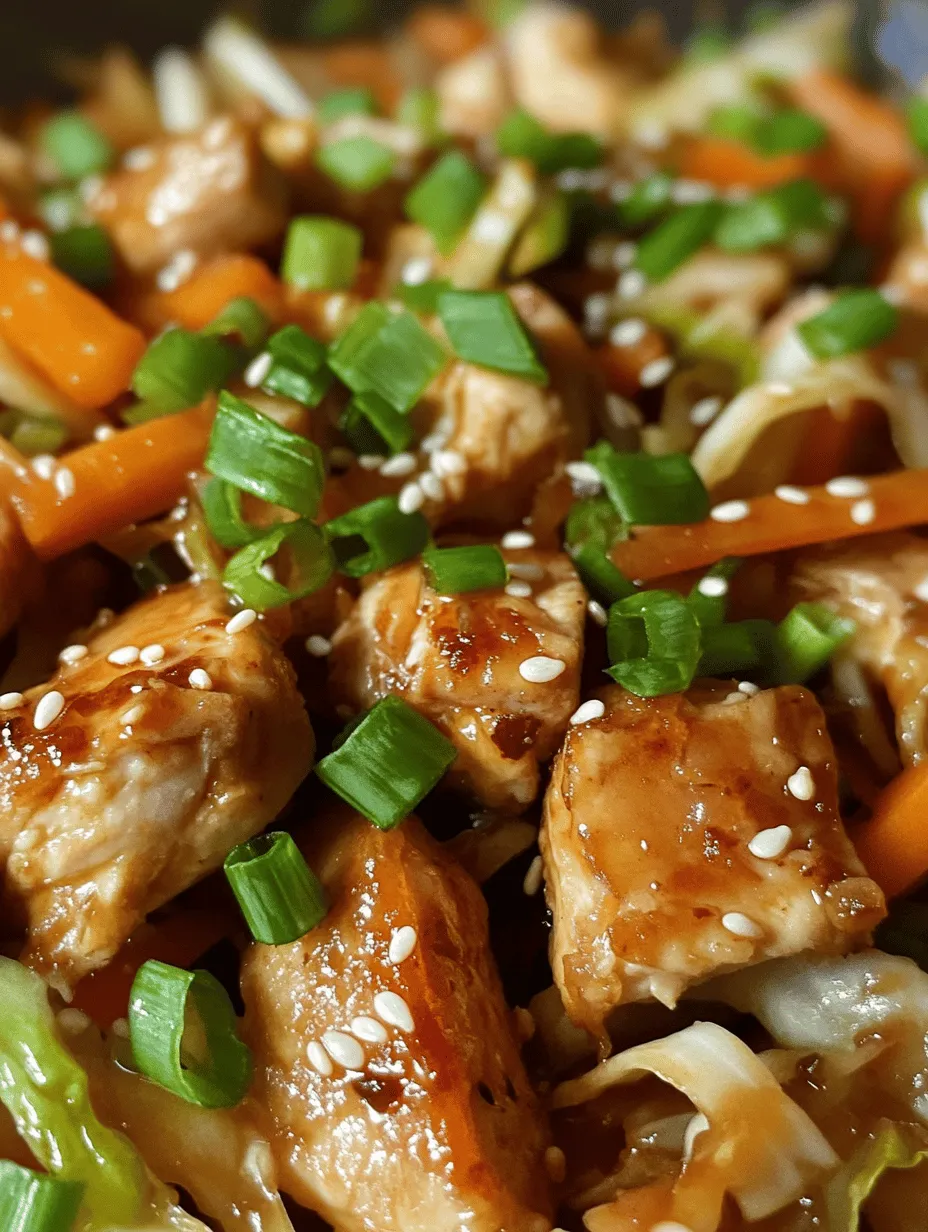Introduction
In the world of quick and delightful meals, there’s an undeniable charm to a well-executed stir fry. One dish that perfectly embodies this ease and flavor is the Savory Chicken and Crunchy Cabbage Stir Fry. This vibrant, colorful dish not only tantalizes your taste buds but also offers a wealth of nutritional benefits. With its combination of lean protein, fresh vegetables, and robust flavors, it’s an ideal choice for anyone looking to whip up a healthy dinner in no time.
What makes this recipe particularly appealing is its versatility and the speed at which it can be prepared. In just about 30 minutes, you can create a satisfying meal that caters to the whole family. It’s a perfect option for busy weeknights, helping you to avoid the temptation of takeout while still enjoying a delicious, homemade dish.
In addition to being quick and nutritious, stir-fries are a staple in many cuisines around the world. They are celebrated not only for their convenience but also for their ability to showcase a variety of ingredients, making them a fantastic choice for using up leftover vegetables or proteins. The Savory Chicken and Crunchy Cabbage Stir Fry is a perfect example of how you can combine flavors and textures to create a dish that is both satisfying and healthful.
Understanding Stir Fry
Definition and Origin of Stir-Fry Cooking
Stir frying is a cooking technique that involves quickly frying small pieces of food in a hot pan with a minimal amount of oil. This method originated in China over 2,000 years ago and has since spread to various cultures, becoming a beloved cooking technique around the globe. The term “stir fry” itself is derived from the Chinese word “chao,” which means “to stir” and “to fry.”
The essence of stir frying lies in its speed and simplicity. By cooking food quickly over high heat, stir frying not only enhances the natural flavors of the ingredients but also preserves their color, texture, and nutrients. This technique is often employed in Asian cuisine but has been embraced worldwide for its practicality and appeal.
Health Benefits of Stir-Frying
One of the standout benefits of stir frying is its ability to retain nutrients. Because the cooking time is brief, vegetables are less likely to lose their vitamins and minerals compared to longer cooking methods. Additionally, stir frying typically requires less oil, making it a healthier cooking option. You can enjoy a flavorful dish without excessive fat, which is a common concern when preparing fried foods.
Stir frying also encourages the use of a variety of colorful vegetables, which are rich in antioxidants, vitamins, and minerals. This method of cooking allows you to pack your meal with different nutrients while keeping it delicious and enjoyable.
Common Ingredients Used in Stir-Fry Dishes
A stir fry can be as simple or as complex as you desire, but there are a few common ingredients that make their way into most traditional stir-fry recipes. These include:
– Proteins: Chicken, beef, shrimp, tofu, or pork are popular choices.
– Vegetables: A mix of fresh vegetables like bell peppers, broccoli, carrots, and cabbage adds color and nutrition.
– Aromatics: Ingredients like garlic, ginger, and onions provide depth of flavor.
– Sauces: Soy sauce, oyster sauce, and teriyaki sauce are commonly used for flavor enhancement.
– Oils: High smoke point oils like vegetable oil or sesame oil are ideal for stir frying.
The beauty of a stir fry lies in its flexibility. You can tailor the ingredients to suit your preferences or what you have on hand, making it a go-to option for creative cooks.
Ingredients Breakdown
To make the Savory Chicken and Crunchy Cabbage Stir Fry, we will be using a selection of fresh and nutritious ingredients. Let’s take a closer look at each component that will contribute to the dish’s delightful flavor and texture.
Chicken: Nutritional Value and Selection Tips
Chicken is a fantastic source of lean protein, making it an excellent choice for a healthy meal. It is rich in B vitamins, particularly niacin (B3) and vitamin B6, which help support metabolism and energy production. When selecting chicken for stir fry, opt for boneless, skinless chicken breasts or thighs. Thighs tend to be juicier and flavorful, while breasts are leaner.
When preparing chicken, cut it into small, uniform pieces to ensure even cooking. Marinating the chicken before cooking can enhance its flavor and tenderness, which we will discuss in the preparation steps.
Cabbage: Types of Cabbage and Health Benefits
Cabbage is the star vegetable in this stir fry, providing a satisfying crunch and a wealth of nutrients. There are various types of cabbage, including green, red, and Napa cabbage. Green cabbage is commonly used for stir fries due to its mild flavor and crisp texture, while red cabbage adds a pop of color and additional antioxidants. Napa cabbage, with its tender leaves, is also a great option.
Cabbage is low in calories and high in dietary fiber, making it an excellent addition to any meal. It is also rich in vitamins C and K, which are important for immune function and bone health, respectively.
Carrots: Nutritional Benefits and Preparation Methods
Carrots add a touch of sweetness and a vibrant orange color to the stir fry. Packed with beta-carotene, which the body converts into vitamin A, carrots are beneficial for eye health and immune support.
When preparing carrots for stir frying, slicing them into thin matchsticks or rounds ensures they cook quickly and evenly. This will allow them to maintain their crunch while blending perfectly with the other ingredients.
Bell Peppers: Color Variations and Flavor Profiles
Bell peppers are another colorful addition to this dish, contributing both flavor and nutrition. They come in various colors, including red, yellow, green, and orange, each offering a slightly different taste profile. Red bell peppers are the sweetest, while green peppers have a more bitter flavor.
Rich in vitamins A and C, bell peppers are excellent for boosting your immune system and promoting healthy skin. For this stir fry, you can choose one color or a mix to create a visually appealing dish.
Garlic and Ginger: Health Properties and Flavor Enhancement
Garlic and ginger are essential aromatics in many Asian dishes, and they play a crucial role in this stir fry. Garlic is known for its immune-boosting properties and ability to enhance heart health, while ginger is praised for its anti-inflammatory effects and digestive benefits.
Chopping or mincing these ingredients releases their natural oils and flavors, providing a fragrant base for the stir fry. Adding them during the cooking process will infuse the dish with a warm, spicy aroma that complements the other ingredients perfectly.
Sauces: Soy Sauce vs. Oyster Sauce and Their Flavor Contributions
The sauce is what brings all the flavors together in a stir fry. Soy sauce is a staple in many Asian cuisines, offering a salty, umami flavor to dishes. It is available in various forms, including light and dark soy sauce. Light soy sauce is saltier and ideal for marinades, while dark soy sauce is richer and thicker, adding depth of flavor.
Oyster sauce is another excellent option, providing a sweet and savory taste that enhances the overall flavor profile of the stir fry. It is made from oyster extracts and can add a delightful richness to the dish. You can use one or both sauces, depending on your flavor preference.
Oils: Benefits of Sesame and Olive Oil in Cooking
Choosing the right oil is essential for stir frying, as it needs to withstand high heat. Sesame oil is a popular choice, known for its nutty flavor and health benefits, including heart-healthy fats. Alternatively, olive oil can also be used, providing a mild flavor and additional health benefits, such as antioxidants.
When stir frying, make sure to use oils with a high smoke point to prevent burning and to achieve that perfect toss of flavors.
Seasoning: The Role of Salt, Pepper, and Red Pepper Flakes
Seasoning is crucial for elevating the taste of your stir fry. A pinch of salt and freshly ground black pepper can enhance the flavors of the ingredients. If you enjoy a bit of heat, consider adding red pepper flakes for a spicy kick.
Balancing the seasoning is key, so be sure to taste as you go, adjusting the flavors to your preference.
Preparation Steps
Now that we have discussed the ingredients and their benefits, let’s move on to the preparation steps to create this delicious Savory Chicken and Crunchy Cabbage Stir Fry.
Step 1: Marinating the Chicken
The first step in preparing the dish is to marinate the chicken. This step is essential for infusing the meat with flavor and tenderness. In a bowl, combine sliced chicken with soy sauce, a splash of sesame oil, minced garlic, and grated ginger. Allow the chicken to marinate for at least 10-15 minutes. If you have more time, marinating for up to an hour will enhance the flavor even further.
Step 2: Preparing the Vegetables
While the chicken is marinating, take this time to prepare your vegetables. Wash and chop the cabbage into bite-sized pieces, slice the carrots into matchsticks, and cut the bell peppers into strips. Mince the garlic and ginger, ensuring they are ready to be added to the stir fry.
Having all your ingredients prepped and organized will make the cooking process smoother and more enjoyable.
Step 3: Stir-Frying the Ingredients
Once the chicken is marinated and your vegetables are prepped, it’s time to stir fry. Heat a tablespoon of oil in a large skillet or wok over medium-high heat. Once the oil is hot, add the marinated chicken, spreading it across the pan. Allow it to cook for about 3-4 minutes until golden brown, stirring occasionally to ensure even cooking.
After the chicken is cooked through, remove it from the pan and set it aside. In the same skillet, add another splash of oil if needed, followed by the minced garlic and ginger. Sauté for about 30 seconds until fragrant, then add the prepared vegetables. Stir-fry the cabbage, carrots, and bell peppers for about 4-5 minutes, or until they are tender-crisp.
Step 4: Combining and Finalizing the Dish
Once the vegetables are cooked, return the chicken to the skillet, along with any juices that may have accumulated. Drizzle in additional soy sauce or oyster sauce as desired, and toss everything together until well combined. Allow the mixture to cook for another 2-3 minutes, ensuring everything is heated through.
Taste and adjust the seasoning with salt, pepper, and red pepper flakes if desired.
Stay tuned for the next part of the article, where we will continue to explore tips for achieving the best results with your stir fry and answer some common questions about this delightful dish!

Importance of Heating the Pan Correctly
When it comes to stir-frying, achieving the perfect texture and flavor hinges significantly on how well you heat your pan. Preheating your wok or large skillet is crucial. A properly heated pan allows for quick cooking and helps to lock in the flavors and nutrients of the ingredients. When the pan is too cold, food can become soggy, and when it’s too hot, it can burn quickly. Aim for a medium-high heat setting to maintain a consistent temperature throughout the cooking process. A few drops of water should evaporate almost instantly when the pan is hot enough, indicating it’s ready for the oil and ingredients.
Tips for Achieving the Right Texture in Vegetables
Vegetables are the star of any stir-fry, and achieving the right texture is vital. Here are some key tips to ensure your vegetables are not only cooked but also retain a delightful crunch:
1. Cut Uniformly: Slice vegetables into uniform pieces to ensure even cooking. Thin strips or bite-sized pieces cook faster and allow for a quick stir-fry.
2. Use Fresh Produce: Fresh vegetables have a better texture and flavor. Look for vibrant colors and firm textures when selecting your cabbage, bell peppers, and other additions.
3. Stir-Fry in Batches: If you have a lot of vegetables, consider cooking them in batches. This prevents overcrowding the pan, which can lead to steaming instead of stir-frying.
4. Add Vegetables in Stages: Start with the vegetables that take longer to cook, like carrots or bell peppers, and add quicker-cooking items like cabbage or bean sprouts later. This staggered approach helps maintain that coveted crunch.
How to Properly Combine Ingredients for Flavor
Combining ingredients effectively is key to maximizing flavor in your savory chicken and crunchy cabbage stir-fry. Here are some strategies to elevate your dish:
1. Marinate the Chicken: Before cooking, marinate the chicken for at least 30 minutes in soy sauce, garlic, and ginger. This enhances the flavor profile and ensures the meat is tender.
2. Layer Flavors: Start by cooking aromatics like garlic and ginger first in the hot oil. This releases their essential oils, creating a flavorful base for the stir-fry.
3. Use High-Quality Soy Sauce: Opt for low-sodium soy sauce to control salt levels while still achieving that umami flavor. You can also experiment with other sauces like oyster sauce or hoisin for added depth.
4. Finish with Fresh Herbs: After cooking, toss in some fresh cilantro or green onions for a burst of freshness and flavor.
Cooking Techniques
Stir-Frying vs. Other Cooking Methods
Stir-frying is a high-heat, quick-cooking technique that originated in China. Unlike boiling or steaming, which can leach nutrients, stir-frying retains the vitamins and minerals in vegetables while providing a delightful texture. The quick cooking time allows food to keep its color and crunch, making stir-fried dishes visually appealing and nutritious.
Tips for Achieving the Perfect Stir-Fry: Heat Control and Timing
The secret to a perfect stir-fry lies in mastering heat control and timing. Here are some essential tips:
1. Preheat the Pan: As mentioned earlier, preheating is essential. Ensure the oil is shimmering before adding your ingredients.
2. Keep it Moving: Stir-frying requires constant movement. Use a spatula or wooden spoon to keep the food moving around the pan, ensuring even cooking without burning.
3. Cook in Order: Always start with proteins, followed by denser vegetables, and finish with more delicate ingredients. This hierarchy ensures everything is cooked perfectly.
4. Don’t Rush: While stir-frying is quick, don’t rush through the steps. Allow the chicken to sear properly before adding vegetables.
Importance of Using a Wok or Large Skillet
Using a wok or large skillet is essential for stir-frying. The design of a wok allows for even heat distribution and provides ample surface area for high-heat cooking. If you don’t have a wok, a large skillet can work, but ensure it has high sides to prevent ingredients from spilling out during stirring.
Flavor Enhancements
Exploring Additional Ingredients for Variation
While the savory chicken and crunchy cabbage stir-fry is delicious as is, feel free to customize it with additional ingredients:
– Tofu: For a vegetarian option, substitute chicken with firm tofu. Marinate it similarly to enhance flavor.
– Other Vegetables: Add snap peas, broccoli, or mushrooms for variety. These not only add different textures but also increase the nutritional value of your dish.
Suggestions for Modifying Spice Levels
If you enjoy a bit of heat:
– Chili Paste or Flakes: Add these during the cooking process for an extra kick.
– Sriracha or Hot Sauce: Drizzle over the stir-fry before serving for a spicy finish.
– Ginger: Fresh ginger adds heat and depth. Consider adding more if you enjoy its flavor.
Ideas for Complementary Side Dishes
To complete your meal, consider serving your stir-fry with:
– Steamed Rice: White or brown rice is a classic pairing, absorbing the flavors of the stir-fry.
– Noodles: Lo mein or rice noodles complement the dish perfectly and can be stir-fried with the same ingredients.
– Spring Rolls: These can serve as a light appetizer alongside your main dish.
Nutritional Information
A serving of savory chicken and crunchy cabbage stir-fry typically contains:
– Calories: Approximately 350-400 calories, depending on the amount of oil and additional ingredients.
– Protein: About 30 grams from the chicken and any added tofu.
– Fiber: Around 5-6 grams, thanks to the vegetables.
– Vitamins: A good source of vitamins A and C from the cabbage and bell peppers.
This dish is not only delicious but also a healthy option. The protein content from chicken aids muscle repair and growth, while the fiber from vegetables helps with digestion. It’s a well-rounded meal that fits into a balanced diet.
Serving Suggestions
Presentation Tips for a Visually Appealing Dish
Presentation plays a crucial role in enhancing the dining experience. Here are some tips:
– Use Color: Incorporate colorful vegetables to make the dish visually appealing. The vibrant greens of cabbage and the reds of bell peppers create a beautiful contrast.
– Garnish: Top with sesame seeds or chopped green onions for an added touch.
– Serve in Bowls: A deep bowl allows you to layer the rice, then top it with the stir-fry, creating an appealing presentation.
Ideal Pairings (Rice, Noodles, etc.)
As previously mentioned, steamed rice or noodles make great companions. For a lighter option, serve the stir-fry over a bed of lettuce for a refreshing take. If you’re feeling adventurous, a side of kimchi or pickled vegetables can add a tangy contrast.
Discussion on Meal Prep and Storage for Leftovers
This stir-fry keeps well for meal prep. Store leftovers in an airtight container in the refrigerator for up to three days. Reheat in a skillet over medium heat or in the microwave. To maintain the crunchiness of the vegetables, avoid reheating for too long.
Conclusion
Savory chicken and crunchy cabbage stir-fry is a delightful dish that brings together flavor, nutrition, and ease of preparation. With its vibrant colors, satisfying textures, and healthy ingredients, it’s perfect for a quick weeknight meal. The versatility of stir-fry allows for endless variations, accommodating different tastes and dietary preferences. Whether you’re a seasoned cook or a beginner, this recipe is accessible and rewarding.
We encourage you to try making this stir-fry, experimenting with your own flavor combinations and ingredients. You’ll find that once you master the basics, the possibilities are endless, and the satisfaction of creating a delicious stir-fry at home is truly unparalleled. Enjoy your culinary journey!


